Great Hammerhead Sharks can be found in many locations in the world, but they are usually larger off the coast of South America, West Africa and Southeast Asia. They have a dorsal fin that is long-based with a “sickle” shape to it.
They also have a stout body with two slanted fins on its back which can grow up to six feet high. Great Hammerhead Sharks have been known to have an aggressive attitude when they feel threatened which means you should keep your distance if you choose to get close to one.
These species are also known for their huge mouths, sharp teeth and triangular teeth rows. They are hunters of the Great Barrier Reef and Great they hunt small fish, squid and other Great Hammerhead Sharks that are smaller in size!
Status: Endangered
Known as: Great Hammerhead Shark, Great Hammerhead.
Estimated numbers left in the wild: Unknown but decreasing (possible 80% loss).
Description of Great Hammerhead Shark
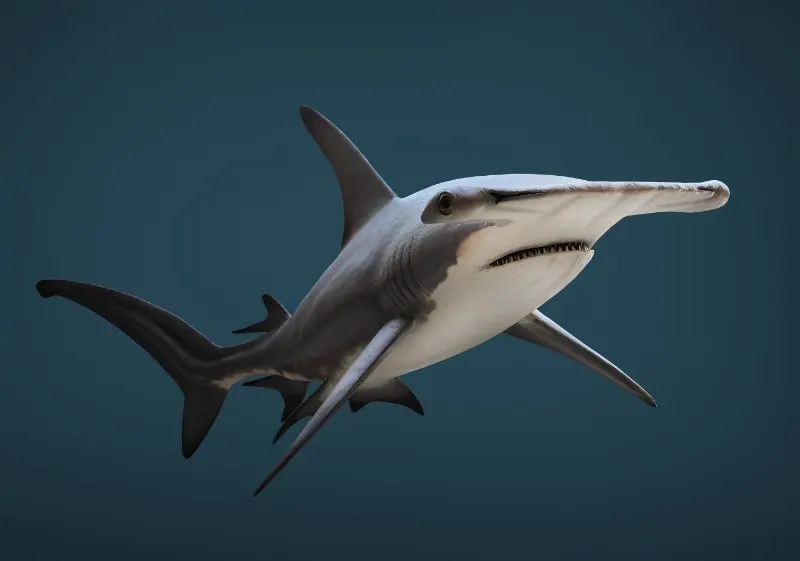
There are nine species of hammerhead shark, varying from small to large, with a wide range of status. The great hammerhead, described here, is a large shark that is usually 4 meters long, but which can reach up to 6 meters at times.
Weight ranges from 230 to 580 kilograms, though most are closer to the lower end of the range and few are heavier than 450 kilograms.
The streamlined, muscular bodies of these large carnivorous fish are similar to those of other sharks, but their distinctive heads – flattened and extended out to the sides with an eye on either extremity – make them instantly recognizable; this head shape is known as a “cephalofoil”.
The back fin of hammerhead sharks is also distinctively tall and sickle-shaped.
The great hammerhead shark is a powerful, active predator that is found both inshore and in deep waters, in tropical, subtropical, and temperate seas.
The positioning of its eyes gives this fish a 360-degree view in the vertical plane, letting it spot and track prey both above and below its current position with great accuracy.
It also has a very strong sense for electrical fields thanks to its ampullae of Lorenzini, which are present in all sharks but which are sensitive enough in hammerheads to detect stingrays hidden under sand on the ocean floor.
Though hammerheads prefer stingrays – and may carry dozens of stingray spines lodged in their mouths with no ill effects – and other rays, they also eat fish, crabs, lobsters, octopuses, and squid.
Occasionally, they eat smaller sharks, including those of their own species. Attacks on humans are rare, and fatal attacks are even rarer, though they are known to occur.
The greater hammerhead shark gives birth to live young after a gestation period of around 11 months. Anywhere up to 55 pups may be born at once, though the usual range is between 20 and 30.
Greater hammerheads can live for up to half a century, though most die in their second or third decade if they are not caught by fishermen.
Check out these other types of sharks around the world.
Location
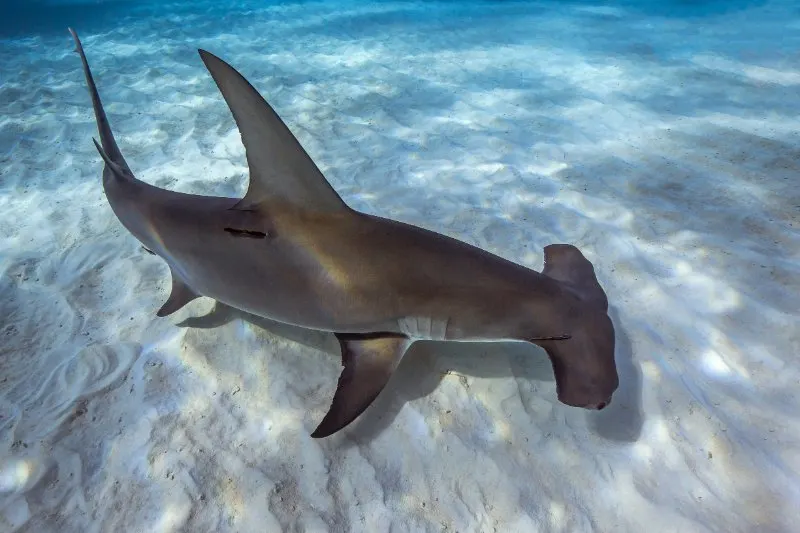
Hammerhead sharks, like many large ocean fish, have a wide range and are found in tropical and subtropical waters around the globe.
They prefer coastal areas where they can easily find a large supply of stingrays on the bottom but have been observed in the open ocean also.
Coral reefs are their favorite habitat but they also live in lagoons and on the continental shelf.
Great Hammerhead Sharks are found in many locations around the world
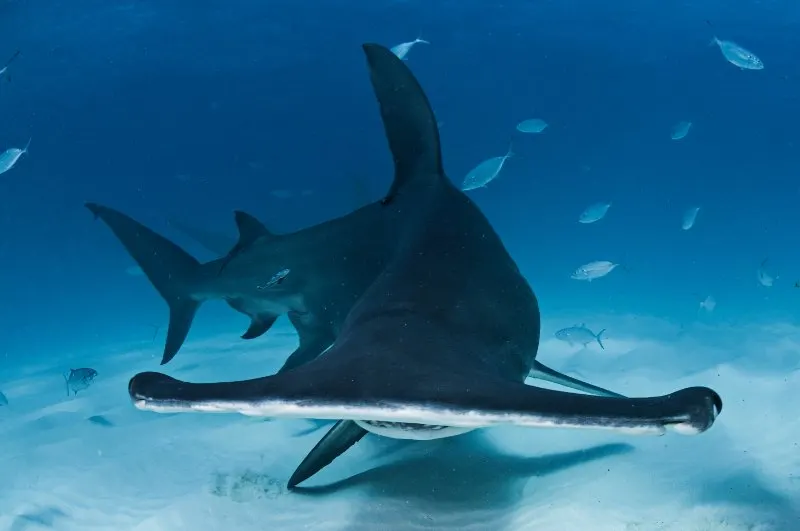
Great Hammerhead Sharks can be found in many locations around the world. They are found in warm, shallow oceans throughout the world. They live in the Atlantic Ocean, Caribbean Sea, and Gulf of Mexico. This species can also be found around Africa and Asia.
They are dangerous because of their aggressive habit as they will attack any other type of shark it comes across. Great Hammerheads have been observed to attack other sharks as well as stingrays and even small whales. They are not Great White Sharks.
They tend to be larger than Great Whites. Its body can get up to 20 feet long and will attack anything that is alive in the water around them.
Great Hammerhead Sharks habitat and swimming habits
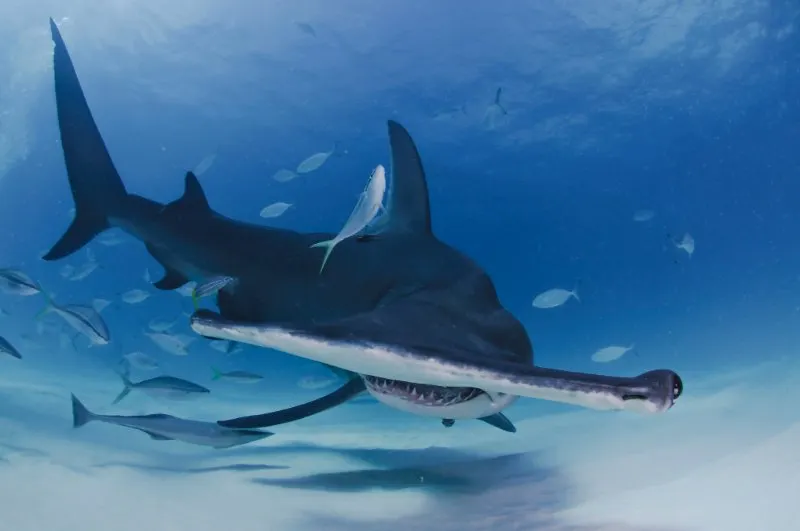
The great hammerhead lives throughout the world’s tropical seas, ranging from 40°N to 37°S. It may be found in the Atlantic Ocean, which extends from North Carolina to Uruguay, including the Gulf of Mexico and the Caribbean Sea, and Morocco to Senegal, as well as the Mediterranean Sea.
It’s found throughout the Indian Ocean and in the Pacific from Okinawa to Australia, New Caledonia, and French Polynesia, as well as southern Baja California to Peru. It may be seen off Gambia, Guinea, Mauritania, Sierra Leone, and Western Sahara; however, this has not been confirmed.
Hammerhead sharks may be found from inshore waters less than 1 m (3.3 ft) deep to a depth of 80 m (260 ft) offshore. They like coral reefs, but they may also be found on continental shelves, island terraces, lagoons, and deep water near the coast.
They migrate; south Florida and the South China Sea populations have been filmed moving closer to the poles over the summer.
In a position known as “rolled swimming,” great hammerheads reduce drag and energy consumption by swimming on their side in a study published in 2016.
The shark’s huge dorsal fin, which it uses to assist with lift, was previously noticed in captive specimens and may spend up to 90 percent of its time in this swimming attitude. The method is thought to save around 10% in drag and thus movement expenses.
See Related: What is Overfishing? Examples & Solutions to Prevent
The Great Hammerhead Shark is endangered
The Great Hammerhead Shark is one of the world’s most endangered sharks, and it is on the verge of extinction. It may reach a length of 20 feet and weighs up to 2,000 pounds. It can be found all throughout the world in warm, shallow seas.
One of the world’s biggest sharks is the Great Hammerhead Shark, which reaches lengths of up to 20 feet. The big, hammer-shaped head of the Hammerhead Shark is distinctive and fascinating; yet, it’s also dangerous. With only 10% of the previous number, this shark species is becoming increasingly endangered.
The majority of great Hammerheads are harvested for their fins. Because they are so recognizable, these species are quite popular.
See Related: Is a Fish an Animal? Here’s What You Need to Know
Conservation
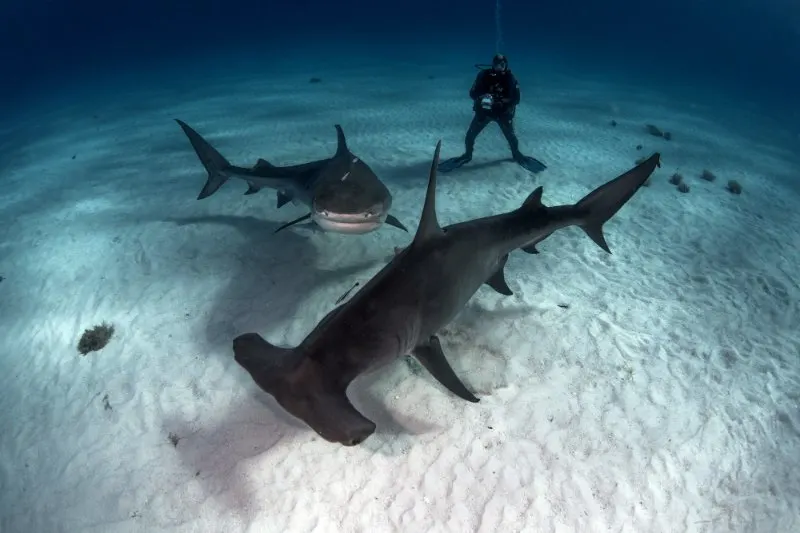
Threats
Overfishing is the chief threat to these fascinating sharks and is driven mostly by Asian demand for shark fin soup. Often, sharks are “finned” after capture and then flung back in the sea alive to slowly die from blood loss or starvation.
Many hammerheads also die as accidental bycatch in large commercial fishing nets in the Atlantic, where the hammerhead is seldom taken for its fins.
Massive illegal fishing of hammerheads occurs in the Indian Ocean and near Africa.
Conservation efforts
Direct conservation efforts for the greater hammerhead shark and other hammerheads is close to non-existent, though shark fin soup is illegal in the European Union, the United States, and Australia.
Much work remains to be done and the highly migratory nature of the shark makes it difficult for specific nations to provide adequate protection.
See Related: Endangered Plants Around the World
Organizations
Do you know of any environmental leaders or are you a part of an organization that works to conserve the Great Hammerhead Shark, then please contact us to have it featured on Our Endangered World.
Conclusion
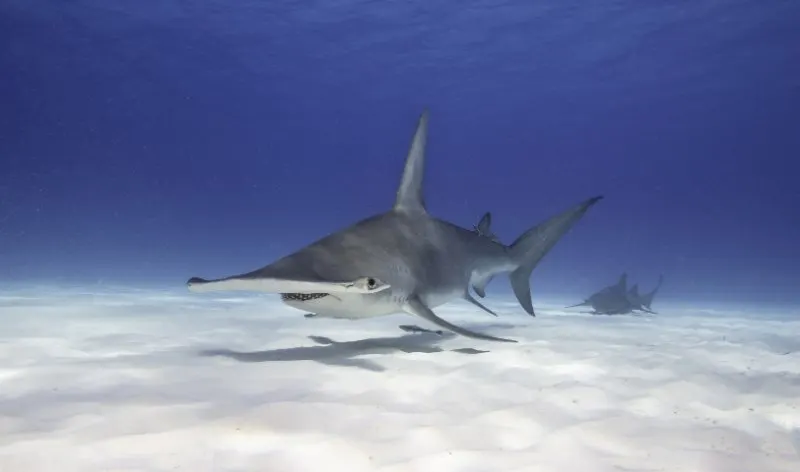
The great hammerhead shark is a critically endangered species. The majority of them die in their second or third decade if they are not caught by fisheries. They will prey on stingrays, which they love because of their powerful sting. They’ll also consume fish, crabs, lobsters, octopuses, and squid.
They will consume other sharks on rare occasions, especially of their own species. They have been known to attack humans, albeit very rarely. They give birth to live pups after a pregnancy of around 11 months and up to 55 at once. Great Hammerhead Sharks can live for more than 50 years, but most perish within 30 years.
The greater hammerhead shark’s conservation efforts are inadequate, and while additional efforts must be made to protect these highly migratory sharks, it is difficult for specific countries to provide adequate protection.
FAQ
What is Great Hammerhead Shark?
The enormous hammerhead (Sphyrna mokarran) is a member of the Sphyrnidae family and has a size range from 4.6 to 6.1 meters long with an average length of 4.6 meters and a maximum length of 6.1 meters.
Great hammerheads are found in both tropical and temperate seas throughout the world, with a preference for coastal regions and the continental shelf. The shape of the “hammer” (also known as the “cephalofoil”) of this species, which is big and nearly straight front portion, distinguishes it from other hammerheads.
The great hammerhead is a solitary, powerful swimmer that feeds on a wide range of prey including crustaceans and cephalopods, as well as bony fish and smaller sharks. In the wild, observations of this species suggest that the cephalofoil serves to immobilize stingrays, which are a favorite food.
This species has a viviparous mode of reproduction, with litters of up to 55 pups every two years.
How many Great Hammerhead Sharks are still in the wild?
The great hammerhead shark (Sphyrna mokarran) is a species of sharks that is critically endangered, with some research suggesting there are as few as 200 remaining in the ocean. Great Hammerheads can be found on both the eastern and western shores of Africa, Australia, Western Europe, North America and Japan.
Great Hammerheads may be found on continental shelves or the outer edges of the ocean floor, where they feed off stingrays with a more sensitive skin. Great Hammerheads will also consume other sharks, including makos, threshers, and duskies.
Great Hammerheads have a gestation period of 11 months, after which they give birth to live pups. The typical duration of the Great Hammerhead’s existence is 50 years, but most perish after 30 due to overfishing.
Is Great Hammerhead Shark endangered?
The endangerment of the Great Hammerhead Shark is a contentious issue, with most experts contending that the species is not endangered, but a few believing differently.
Hammerhead populations in the Mediterranean and off the coast of Florida have been on a downward trend since 1990, according to some studies—including IUCN Blue List Panel’s consensus reports and an independent analysis published in Marine Policy—but they do not qualify as critically endangered.
The long-term protection and survival of Great Hammerheads depends on legislative safeguards that limit fishing pressure in order to guarantee their resurgence can continue.
For example, Bermuda has passed a law prohibiting shark tourism to minimize the impact on these animals from snorkellers and spearfishers while allowing them to be hunted and killed by commercial and subsistence fisheries.
Great Hammerheads are frequently caught in tuna and swordfish nets. Despite the fact that they target the same species, these species are more likely to be captured when fishing for tuna or swordfish because they are larger in size and have a wider gill net spread.
Great Hammerhead Sharks are listed as endangered by the International Union for Conservation of Nature. They have been classified as an endangered species on the IUCN Red List since 2006.
See Related
Related Resources
